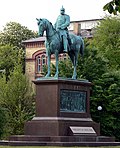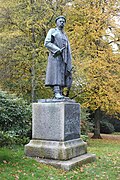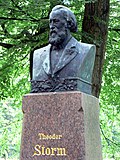Adolf Brütt
Adolf Carl Johannes Brütt (born May 10, 1855 in Husum ; † November 6, 1939 in Bad Berka ) was a German sculptor and medalist .
Brütt founded the Weimar School of Sculpture , which opened on November 1, 1905 and worked together with the Schwarzburg workshops for porcelain art. In 1910 Brütt returned to Berlin and Gottlieb Elster was his successor. In front of the training workshops and master studios in the so-called arts and crafts school building later used by the Bauhaus Weimar , Brütts “Mädchenfigur” (1907) stood until around 1926. The studio building of the sculpture school and the Weimar School of Applied Arts, which opened in the attached south wing in 1907, have been UNESCO World Heritage Sites since 1996 .
Adolf Brütt was the son of the painter Barthold Friedrich Brütt.
Life
Kiel
Brütt was trained as a stonemason by Adolf Müllenhoff (1831–1899) in Kiel and worked on his wanderings at Linderhof Palace, among other places . A scholarship from the Kieler Spar- und Leihkasse enabled him to study at the Akademie der Künste (Berlin) , where he stayed for several years (1875–1878), including three semesters as a student of Schaper. As a master student of the sculptor Leopold Rau (1847-1880) he became known for the early work of Friedrich Nietzsche . In the following years he worked a. a. in the Munich workshop of Karl Begas , brother of the neo-baroque sculptor Reinhold Begas .
Berlin 1883-1905
In 1883 Brütt emigrated to Italy with his school friend Hans Olde . In the same year Brütt married and built a light rail arch on Schiffbauerdamm into a studio and soon had success. His Fischer (1887; formerly in front of the National Gallery in Berlin; then in Flensburg until 2009) is back on the newly designed Museum Island in Berlin. In 2010, the Flensburg Beautification Association set up a replica of the sculpture in the same place. Another replica is in Heikendorf near Kiel ), his Eva (1889, Nationalgalerie Berlin, today Stadttheater Flensburg, bronze version of Gottorf Castle ) and his sword dancer (1891/93; Kiel Town Hall) made him internationally famous (gold medal world exhibition Paris 1900 ), who became the leading figure of the Munich Secession in 1893 Brütt was one of the founding members. In 1890 he moved into the studio building at Lützowstrasse 82 , where he worked until 1900, at times at the same time as painters from the Berlin Secession . His student Anita Nordenholz transformed the figure into a fighting woman for the International Women's Congress in Berlin in 1904 . Accordingly, his Diana (1903, Nationalgalerie Berlin) reflects more the emancipation of the naked female body than Brütt's enthusiasm for hunting , which then linked him to the Weimar lawyer Georg Mardersteig , who was important for German hunting legislation .
Alongside Conrad Fehr, Brütt was a co-founder of the Fehr Academy in Berlin, which was closely related to the secessions , had the title of professor, was a member of the Prussian Academy of Arts and its senator.
From 1902 Brütt continued his work in his native Husum, for which he had already created the bust of the poet and writer Theodor Storm , unveiled in 1898 . It emerged u. a. the Asmussen-Woldsen monument known as the Tine Fountain , which has become a landmark of the city. As with the provincial monument to Kaiser Wilhelm I in front of the main building of the Christian-Albrechts-Universität Kiel, which was destroyed in World War II , with the relief of the destruction of the Danish warship Christian VIII off Eckernförde in 1849, Brütt monumentalized the events of the German Imperial War against Denmark : statue of the general Baron Karl von Wrangel in Flensburg's city park , September 27, 1903, and Friedrich von Esmarch in Tönning, 1904. For Schleswig-Holstein , Brütt also created the preserved Bismarck statues for Knivsberg and Altona in a green area on Königstrasse ( Schleepark , near Behnstrasse).
Which at that time highly prized statue of the Margrave Otto of the sluggard ( Monument Group 12 ) was created in 1899 for the Victory Boulevard , the group Friedrich Wilhelm II. ( Group 29 ) followed in 1900. On December 18, 1901, he completed the Siegesallee solemnly. The unveiling of Brütts portrait bust of Carl Humann in the Pergamon Museum linked the project of Siegesallee programmatically with the ancient victory over the Gauls who invaded Asia Minor .
In the course of adding groups 33 and 34 to the 32 groups originally planned, Brütt created the Kaiser Friedrich group in 1903, the concept of which the entire complex was originally based on. At the suggestion of Adolph von Menzel , the subsequent erection of Brütts statue Wilhelm Prince v. Prussia returns in the uniform of the wars of freedom . This established the connection to the Kaiser Wilhelm Memorial Church with the marble reliefs by Brütt, which were then completed in Weimar. In 1903 he received a large gold medal at the Great Berlin Art Exhibition .
Weimar 1905-1910
Since his Otto the Lazy Brütt sought to break away from Berlin historicism. Brütt was friends with the influential Berlin banker Felix Koenigs († 1900), whose estate, which was actually intended as the nucleus of a Berlin Secession Museum, he transferred to the Berlin National Gallery, which in 1901 came to work by French Impressionists and Auguste Rodin . The sculptor Max Klinger and Brütts childhood friend, the painter Hans Olde , also belonged to the circle of artists around Koenigs . To build up the New Weimar , Olde appointed him professor of sculpture at the Weimar Art School in 1905 , where Brütt built the aforementioned Weimar School of Sculpture and bronze foundry.
The marble seat of Theodor Mommsen (1909), created in Weimar , is the background of Heiner Müller's long poem “ Mommsen's Block ” on the occasion of its return to its old location in front of the Berlin Humboldt University . Brütts Nacht (1907), which deals with Leopold Rau's early encounter with the work of Friedrich Nietzsche, is now in the Bauhaus University in Weimar.
Together with his students, Brütt created the marble reliefs of poets and musicians in the entrance hall of the new court theater in Weimar, which opened in 1908 . The portrait of Friedrich Schiller formed the basis of the Schiller plaque donated by Minister of State Carl Rothe in 1909 to the German Schiller Foundation , which was awarded to the poet Paul Heyse in 1910 .
Brütts' equestrian image of Grand Duke Carl Alexander , conceived as an urban development pivot , unveiled on June 24, 1907, a reminder of his advocacy for the German constitutional state of 1849 in the Schleswig-Holstein War . Erected at the same time as the protection of Weimar's old town, which was protected by Carl Alexander, stood in the way of political access to Berlin anchored in Weimar, was removed in 1938 and has been missing since 1946. 2003–2005 a work by Dieter M. Weidenbach visualized the equestrian image of Brütts on the original plinth in front of Weimar's old town. Since May 1, 2005, this visualization of Carl Alexander has been standing in front of the hunting arsenal in Bad Berka.
While still in Weimar, Brütt designed the town hall fountain for Kiel in the shape of the Roland image and thus created an exemplary monumental work of self-confident male nudes - the "Bronze Age" sword following his "sword dancer " donated to the city of Kiel in 1904 in the run-up to the planned Berlin Olympics of 1916 connected the statue with the melted base group of the Kaiser Wilhelm monument "Schleswig-Holstein" and referred to the pre-Prussian state history. On the occasion of the redesign of the town hall forecourt for the 1972 Summer Olympics, the statue was rotated 180 ° and has been facing the town hall ever since. The spirit warrior of his sculptor colleague Ernst Barlach became the counterpart to Brütt's work after the First World War .
Works
People and events
- 1887 Der Fischer , also known as Saved , bronze, 176 cm, acquired from the National Gallery Berlin , it is now on loan on the Flensburg Museum Hill. The group is used as an emblem by the German Lifesaving Society
- 1887/1894 Der Fischer , also called Saved , bronze, 176 cm, erected in 1991, second casting, Heikendorf
- 1888 Statuette Phryne , bronze, 52 cm, Husum, North Frisian Museum. Nissenhaus Husum
- 1889 Eva and her children , bronze, 169 cm, Schloss Gottorf Sculpture Park , Schleswig, State Museum
- 1896 sword dancer , bronze, 206 cm, Kiel, town hall rotunda
- 1890 helmsman , building sculpture, copper drifting work, approx. 400 cm, today Kiel, NDR building
- 1894 fishing , marble, approx. 220 cm, Berlin, tower hall in the Rotes Rathaus
- 1896 equestrian statue of Kaiser Wilhelm I , bronze, approx. 300 cm, Kiel, palace garden
- 1898 Statue of Bismarck , bronze, approx. 300 cm, Hamburg-Altona, green area on Königstrasse
- 1898 bust of Theodor Storm , bronze, Husum, palace gardens
- 1899 (unveiling) Group 12 of Siegesallee, statue of Otto von Wittelsbach the lazy , busts of Thilo von Bruges and Thilo von Wardenberg , marble, larger than life, preserved damaged, Spandau citadel
- 1900 (unveiling) Group 29 of Siegesallee, statue of Friedrich Wilhelm II , busts of Grand Chancellor Count Carmer and Immanuel Kant , marble, larger than life, preserved headless, Spandau citadel
- 1900 Apostle Thomas and Apostle James , sandstone, approx. 500 cm, Berlin, outside of the cathedral
- 1901 female figure , bronze, 43 cm, Husum, North Frisian Museum. Nissenhaus Husum; also marketed downsized as a porcelain figure
- 1902 Asmussen-Woldsen-Brunnen , also Tine-Brunnen , granite fountain with approx. 200 cm high bronze sculpture, Husum, market square
- 1903 (unveiling) Group 33 of Siegesallee, statue of Friedrich III, German Emperor , busts Generalfeldmarschall Blumenthal and Hermann von Helmholtz , marble, larger than life, only the bust of Blumenthal preserved, Spandau citadel
- 1903 statue of General Wrangel , bronze, approx. 300 cm, Flensburg, Stadtpark
- 1904 statue of Wilhelm Prince of Prussia , marble, approx. 250 cm, Berlin-Tiergarten, Kleine Luisen-Insel near Philharmonie
- 1904 Christ statue for the new construction of the St. Jürgen Church in Kiel, lost in the Second World War, but found again in 2008
- 1905 Friedrich von Esmarch (statue, bronze) in the castle garden of Tönning
- 1905 portrait plaque for Alexander Conze
- 1906 (inauguration) Reliefs from the life of Kaiser Wilhelm I , Carrara marble, Berlin-Charlottenburg, ruined tower of the Kaiser Wilhelm Memorial Church
- 1907 Nacht , marble, approx. 200 cm, Weimar Art School
- 1909 Opus 100 , marble, 83 cm, Berlin-Wedding, waiting room at the court street in the crematorium
- 1909 Seated picture Theodor Mommsen , marble, approx. 250 cm, Berlin-Mitte, Ehrenhof of the Humboldt University
- 1912 swordtail , bronze, approx. 300 cm, Kiel, Rathausmarkt
- 1913 Waidwund , marble, 185 cm, Berlin-Schöneberg, town hall, Brandenburghalle
- 1926 woman's hair , marble torso, 95 cm, Kiel, Kunsthalle
Portrait plaque Alexander Conze
Portraits
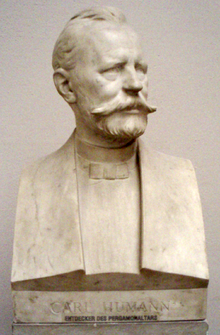
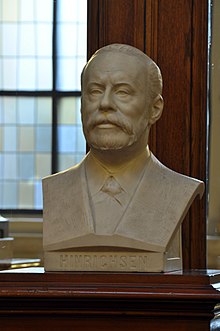
- Wilhelm Ahlmann
- Alexander Conze
- Lucas von Cranach
- Erich Wolf Degner
- Curt Elschner
- Friedrich von Esmarch
- Ludwig Franzius
- Rudolph Hertzog
- Siegmund Hinrichsen
- Carl Humann
- Michael Jebsen
- Leonhard Richard Karl
- Richard Koch
- Felix Koenigs
- Hans Christian Lange
- Rochus of Liliencron
- Wilhelm Martens
- Theodor Mommsen
- Hans Olde
- Eugen Petersen
- Julius Carl Raschdorff
- Eduard Sachau
- Theodor Storm
- Johannes Vahlen
- Karl Waechter
- Karl von Wrangel
student
estate
Brütts estate came to the Nissenhaus-Nordfriesisches Museum , today's North Frisian Museum. Nissenhaus Husum .
Appreciation
- Gold medals from exhibitions in Berlin, Paris, Melbourne, St. Louis in 1904 and Chicago in 1893
- Order of the Red Eagle
- 4th class 1897
- 3rd class with the 1902 ribbon
- Honorary Citizen of Bad Berka (1928)
literature
- Brütt, Adolf . In: Ulrich Thieme (Hrsg.): General Lexicon of Fine Artists from Antiquity to the Present . Founded by Ulrich Thieme and Felix Becker . tape 5 : Brewer-Carlingen . EA Seemann, Leipzig 1911, p. 109 ( Textarchiv - Internet Archive ).
- Cornelius Steckner : The sculptor Adolf Brütt . Husum 1978 (= writings of the Nissenhaus - North Frisian Museum ) in Husum No. 13
- Cornelius Steckner: The thrift of the elderly. Cultural and technological change between 1871 and 1914 in its effect on the design of the sculptor Adolf Brütt (1855–1939) (= Neue Kunstwissenschaftliche Studien Vol. 11) Frankfurt / M. / Bern 1981, ISBN 3-8204-6897-8 , X, 128 p. 57 fig.
- Cornelius Steckner: The sculptor Adolf Brütt. Schleswig-Holstein. Berlin. Weimar. Autobiography and catalog raisonné. (Writings of the Schleswig-Holstein State Library. Ed. Dieter Lohmeier . Volume 9). Heide 1989. ISBN 3-8042-0479-1 .
- Cornelis Steckner: The sculptor Adolf Brütt . Autobiography and catalog raisonné. Verl.-Anst. Boyens, Heide 1989, ISBN 978-3-8042-0479-9 .
- Vor-Reiter Weimar, The Grand Dukes Carl August and Carl Alexander in the memorial . Edited by the Friends of the Goethe National Museum, Glaux, Jena 2003, ISBN 3-931743-53-5 .
Web links
- Literature by and about Adolf Brütt in the catalog of the German National Library
- Pedestal of the Carl Alexander monument on Goetheplatz in Weimar.
- Adolf Brütt honor and sculpture symposium of the city of Bad Berka May 1, 2005 - September 18, 2005.
- Sword dancer , 1891/93. cast by Hermann Gladenbeck
- Kiel Memorial Day: October 19, 1912 - Sword Bearer Fountain inaugurated in front of the town hall
- Husum market square with Tine fountain by Adolf Brütt
- “Saved” bronze by Adolf Brütt - Factual place of origin: Berlin, 1887/1892. Group (2-figure), free sculpture, round sculpture (back worked out). Bronze, cast . Photo archive Photo Marburg
- Adolf Brütt: The fisherman or saved (bronze, 1887/1894) Flensburg and Möltenort, and since 1991 in 24226 Heikendorf .
- Museum Mountain: Saved! But now for ever - “Flensburger Tageblatt” from April 19, 2010
- KUNST @ SH: Adolf Brütt - Art in the public space of Schleswig-Holstein & Hamburg
Individual evidence
- ↑ artist. Adolf Brütt. German Society for Medal Art , accessed on November 6, 2019 .
- ↑ Adolf Brütt: The fisherman - Saved, portrait. Retrieved September 14, 2018 .
- ↑ Gunnar Dommasch: Berlin gets a Fischer figure. In: Flensburger Tageblatt. sh: z Schleswig-Holsteinischer Zeitungsverlag, May 22, 2009, accessed on September 14, 2018 .
- ↑ Flensburger Tageblatt: Saved! But now for ever (Holger Ohlsen), April 19, 2010 , accessed on September 29, 2017
- ↑ a b Adolf Brütt: The fisherman, portrait. Retrieved September 14, 2018 .
- ↑ Berlin address book
- ^ A b Adolf Brütt: Theodor Storm bust. Retrieved September 14, 2018 .
- ^ A b Adolf Brütt: Tine fountain. Retrieved September 14, 2018 .
- ^ A b Adolf Brütt: General von Wrangel. Retrieved September 14, 2018 .
- ^ Adolf Brütt: Friedrich von Esmarch. Retrieved September 14, 2018 .
- ↑ Caricature of the statue of Margrave Otto the Lazy "Funny Leaves" 1899
- ↑ Sinn und Form , 1993, pp. 206-211
- ↑ schillerstiftung.de
- ↑ KUNST @ SH: Description of the sculpture, location, photos , accessed on March 1, 2018
- ↑ Adolph Brütt: Eva and the children. Retrieved September 14, 2018 .
- ^ Adolph Brütt: sword dancer. Retrieved September 14, 2018 .
- ^ Adolph Brütt: helmsman. Retrieved September 14, 2018 .
- ^ Adolph Brütt: equestrian statue of Kaiser Wilhelm I. Accessed on September 14, 2018 .
- ↑ St. Jürgen Community Association e. V. (Ed.): Chronicle of St. Jürgen in Kiel . 4th edition. 2009, p. 203 .
- ↑ Stefan Krmnicek, Marius Gaidys: Taught images. Classical scholars on 19th century medals. Accompanying volume to the online exhibition in the Digital Coin Cabinet of the Institute for Classical Archeology at the University of Tübingen (= From Croesus to King Wilhelm. New Series, Volume 3). University Library Tübingen, Tübingen 2020, p. 52 f. ( online ).
- ↑ Adolph Brütt: sword bearer. Retrieved September 14, 2018 .
- ↑ Hertzog, Rudolph . In: District lexicon of the Luisenstädtischer Bildungsverein
| personal data | |
|---|---|
| SURNAME | Brütt, Adolf |
| ALTERNATIVE NAMES | Brütt, Adolf Carl Johannes (full name) |
| BRIEF DESCRIPTION | German sculptor |
| DATE OF BIRTH | May 10, 1855 |
| PLACE OF BIRTH | Husum |
| DATE OF DEATH | November 6, 1939 |
| Place of death | Bad Berka |




